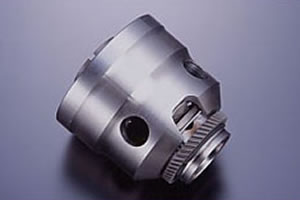


Uprated center viscous diffs are engineered to provide either a 20kgf-m/100rpm or 12kgf-m/100rpm torque transfer rate compared the 4kgf-m/100rpm factory specification. LSD response and durability is increased while traction on loose surfaces is significantly improved. However, tight cornering understeer on pavement can be a problem. For this reason it is suggested that a 20kgf viscous only be used primarily for gravel and loose surfaces while the 12kgf unit can be used with much less adverse effect on pavement and is more suitable for street and track use.
Usually ships in 1 to 2 weeks.
How does a viscous differential work? A viscous differential uses a set of thin plates that are closely spaced but not touching. The plates are alternately splined half to one of the differential's side gears and half to the differential case. The plates are sealed within a chamber that is partially filled with a special silicone-based viscous fluid. The side and pinion gears are arranged similarly to an open differential. However, when a difference in speed occurs between the two axles (during wheel slip) there will be a relative motion between the plates which is counteracted by the shear stress in the viscous fluid which transfers torque from one opposing plate to the other, thus redirecting some torque to the axle with greater traction. The shear stress also causes a temperature increase in the viscous fluid which expands. A "hump" mode occurs when the viscous fluid expands to the full volume of the chamber size and causes the inner plates to slide axially until they are in contact with the outer plates creating a significant increase in torque transfer capability.
System performance is tuned by the manufacturer by altering the fluid viscosity, number & size of the plates, and the fluid fill capacity. Performance is rated by the torque transfer rate per speed differential. For example, the standard Subaru viscous differentials are rated at 4kgf-m/100rpm. That is the differential will transfer 4kgf-m of torque for each 100rpm speed difference between the axles. Most of the motorsport viscous diffs from STI are rated at 20kgf-m/100rpm. Often they are referred to as "20 kg" or "20 kilogram" units.
Are the viscous units serviceable? No, they are sealed units with no serviceable parts. The viscous fluid is sealed inside the unit.
The snap ring holding the cover of my viscous center diff has broken, what does that mean? This is usually an indication that the unit has been overstressed causing the fluid temperature to continue to rise due to plate shear even beyond the "hump" mode and the expansion forces were enough to break the snap ring holding the cover in place. It is likely that the internal plates may be damaged and/or the fluid has exceeded its normal operating range. The unit should be replaced. Subaru does not sell a replacement snap ring.
What applications are the heavy duty viscous units best suited for? Loose surface applications such as gravel rally and rallycross. Perhaps also drag racing. The high torque transfer rate at low speed means that the unit will try to fight the wheel speed differences that occur during normal tight radius cornering. Therefore the car will suffer understeer on tight corners. This is less of an issue on a gravel rally car because the driving style can be adjusted more easily to force the car to rotate.
How does a viscous LSD compare to Torsen® and clutch type LSD's? A viscous limited slip is a speed sensing differential and therefore there will be a larger time delay for the unit to respond when compared to a torque sensing differential. For a motorsport application a gear or clutch type LSD will usually offer superior performance with less of a negative handling penalty. For a general street application, the viscous LSD's noiseless operation and longevity may be beneficial. However, for center differentials there is often few options in terms of aftermarket limited slips so a heavy duty viscous unit or a factory viscous unit may be the only options to choose from.
What is the best upgrade path for differentials in an AWD application such as a Subaru? Usually we suggest upgrading the front differential first because it will greatly assist in allowing the driver to get on the power as early as possible out of the corner. The rear diff is generally the second to be upgraded and will allow for a stable and predictable rotation and straight line acceleration and braking on loose surfaces/wet pavement or with large power outputs. In cases where the car has large power output and is an open diff from the factory, it may be better to start by upgrading the rear diff first. The center diff is almost always the last upgrade although for loose surface applications it may be necessary to upgrade this first to ensure sufficient reliability.